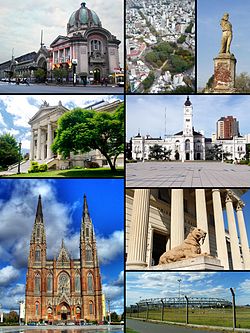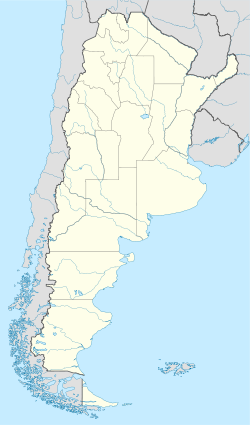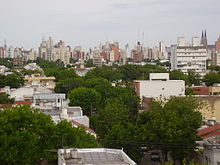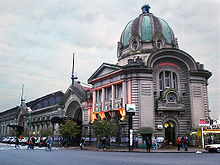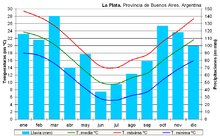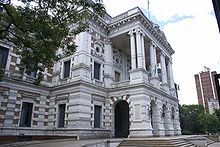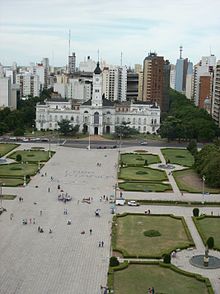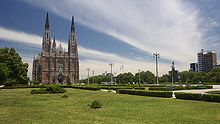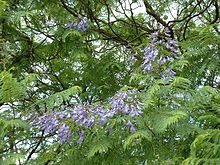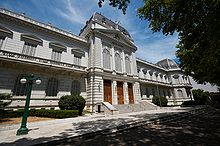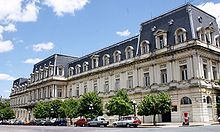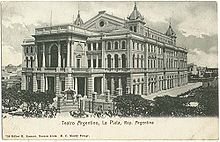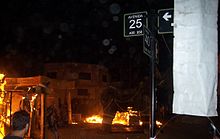- La Plata
-
For other places with the same name, see La Plata (disambiguation).
La Plata Ciudad de La Plata From top left: Estación del Ferrocarril Roca • High view of Plaza Dardo Rocha • Garibaldi's statue • Legislatura Provincia de Buenos Aires • Palacio Municipal • Catedral • Museo de Ciencias Naturales • Estadio Ciudad de La Plata. 
Coat of armsLocation in Argentina Coordinates: 34°55′16″S 57°57′16″W / 34.92111°S 57.95444°WCoordinates: 34°55′16″S 57°57′16″W / 34.92111°S 57.95444°W Country  Argentina
ArgentinaFounded 1882 Founder Dardo Rocha Government – Intendant Pablo Bruera – Senators Area – City 203 km2 (78.5 sq mi) – Land 203 km2 (78.5 sq mi) – Metro 4,758 km2 (1,837.1 sq mi) Elevation 26 m (85 ft) Population (2001)2001 census [INDEC] – City 563,943 – Density 2,778/km2 (7,195.1/sq mi) – Metro 694,253 Demonym platense Time zone ART (UTC−3) CPA Base Area code(s) +54 221 Website http://www.laplata.gov.ar La Plata (English: The Silver) is the capital city of the Province of Buenos Aires, Argentina, and of La Plata partido. According to the 2001 census [INDEC], the city proper has a population of 574,369 and its metropolitan area has 694,253 inhabitants.
La Plata was planned and developed to serve as the provincial capital after the city of Buenos Aires was federalized in 1880, and it was officially founded by Governor Dardo Rocha on 19 November 1882. Its construction is fully documented in photographs by Tomás Bradley Sutton.[1] La Plata was renamed Eva Perón City (Ciudad Eva Perón) between 1952 and 1955.
The city is home to two football (soccer) teams that play in the first division: Estudiantes de La Plata and Gimnasia y Esgrima La Plata.
Contents
History and description
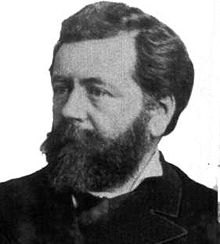 Governor Dardo Rocha (1838-1921), founder of La Plata.
Governor Dardo Rocha (1838-1921), founder of La Plata.
Rocha decided to erect a new city to host the provincial government institutions and the planned university. Urban planner Pedro Benoit designed a city layout based on a rationalist conception of urban centers. The city has the shape of a square with a central park and two main diagonal avenues, north-south and east-west. (In addition, there are numerous other shorter diagonals.) This design is copied in a self-similar manner in small blocks of six by six blocks in length. Every six blocks, one finds a small park or square. Other than the diagonals, all streets are on a rectangular grid, and are numbered consecutively. Thus, La Plata is nicknamed "la ciudad de las diagonales" ("city of diagonals"). It is also called "la ciudad de los tilos" ("city of tilia (linden trees)") because of the large number of linden trees lining many streets and squares.
The city design and its buildings are said to possess a strong Freemason symbolism. This is said to be a consequence of both Rocha and Benoit being Freemasons.
The designs for the government buildings were chosen in an international architectural competition. Thus, the Governor Palace was designed by Italians, City Hall by Germans, etc. Electric street lighting was installed in 1884, and was the first of its kind in Latin America.
The cathedral of La Plata, in neo-Gothic style, is the largest church in Argentina.
The Curutchet House is one of the two buildings by Le Corbusier in the Americas. The Teatro Argentino de La Plata is the second most-important opera house in Argentina after the Teatro Colón in Buenos Aires.
The University of La Plata was founded in 1897 and nationalized in 1905. It is well-known for its observatory and natural history museum. Ernesto Sabato graduated in physics at this university; he went on to teach at the Sorbonne and the MIT before becoming a famed novelist. Doctor René Favaloro was another famous alumnus. During its early years, it attracted a number of renowned intellectuals from the Spanish-speaking world, such as Dominican Pedro Henríquez Ureña.
La Plata in the twentieth century
Under Alvear's administration (1922–1928), Enrique Mosconi, the president of the oil state company Yacimientos Petrolíferos Fiscales, created the distillery of La Plata, which was the tenth largest in the world.[2]
On 10 December 1945, in the Parish of St. Francis of Assisi in this city, Juan Domingo Perón and Eva Duarte married.[3]
The city was renamed in 1952 as Eva Perón, though the original name was restored in 1955. La Plata's residents are served by numerous daily newspapers, the most prominent of which is El Día.
It was filmed in the 1997 film "Seven Years in Tibet", which featured a performance by Brad Pitt, David Thewlis, BD Wong, Mako, Danny Denzongpa, Victor Wong, Ingeborga Dapkunaite and Jamyang Jamtsho Wangchuk, among others. Location was used as a local train terminal, having a design similar to the train in Austria. The film belongs to the drama and was shot mostly in the U.S. and in the province of Mendoza, Argentina.
In October 1998, UNESCO approved the city's bid to gain recognition as a Heritage of Humanity. The distinction is still pending due to various objections to the criterion of maintaining architectural and landscape over recent decades, which in the opinion of other specialists has produced severe damage to the original design and contextual aesthetics.[4][5][6][7]
Present
On June 7, 2003 opened the Estadio Ciudad de La Plata, one of the most modern in Latin America, even without having completed all the planned works.
On 28 October 2007 Pablo Bruera was elected Mayor with 26% of the vote, replacing Julio Alak, who had been in charge since 1991.
During 2009, following a series of agreements between the city municipality, the governor of the province and the nation's presidency, progress was made in the final transfer of the land of the Paseo del Bosque to Estudiantes and Gimnasia clubs. 24 June, the Deliberative Council adopted the Convention and the ordinance for which Gimnasia and Estudiantes clubs receive in character "grant from" the lands where they currently stand their grounds in El Bosque (The Forest).
On February 25, 2009 debuted the parking system via text messages (sms). With this fact, La Plata became the first city in Argentina to use technology applications class to control the parking lot.
In April 2009, reopened its doors as Pasaje Rodrigo shopping. The mall was opened in 1929 by Basilio Rodrigo (Spanish immigrant) and had being closed to the public for 10 years.
In 2011, the Estadio Ciudad de La Plata will be the site of the Copa America Cup, which after 24 years will be played in Argentina, with head in seven provinces.
Geography
Location
Located in the northeastern province of Buenos Aires, limiting to the northeast with Ensenada and Berisso, northwest with the Berazategui and Florencio Varela, southwest and south, with San Vicente and Coronel Brandsen and southeast with Magdalena, occupying an area of 893 km.
The metropolitan area of La Plata includes besides the founding of the town, the towns of Tolosa, Ringuelet, Manuel B. Gonnet, City Bell, Villa Elisa, Melchor Romero, Abasto, Gorina, José Hernández, Ángel Etcheverry, Arturo Seguí Los Hornos, Lisandro Olmos, Villa Elvira and, Altos de San Lorenzo, all of them with community centers that operate as local delegations.
Time zone
Climate
Usually warm and humid in the summer. Mild winters.
Average temperature: 16.7°C
Average clear days: 126 Rain: 1023 Mn
Average humidity: 78%Snow
Snowfall in the city are rare. The last significant snowfall fell on 9 July 2007. The second last snowfall was on 22 June 1918.
Earthquakes
The region responds to the "failure of Punta del Este" and its ultimate expression occurred on 5 June 1888 (122 years), at 3.20 UTC-3 with a magnitude of 5.5 on the Richter scale. (Earthquake of Rio de la Plata, 1888.)
Government
Given the federal system of government in Argentina there are 3 orders or ranks: the National, Provincial and Municipal. Thus it is referring to the three branches in each of these tiers.
The executive branch in La Plata, is exercised by the municipal mayor, elected by popular vote every four years with the possibility of unlimited reelection. The government building is known as the Palacio Municipal, located between the streets 51, 53, 11 and 12, in the city center, is separated from the cathedral across the plaza Moreno. The current mayor is Paul Bruera.
The city government is divided into different areas. These are: Private Secretary, Secretary General, Ministry of Economy, Ministry of Public Management, Social Development Secretariat, Ministry of Culture, Ministry of Modernization and Economic Development, Ministry of Justice Faltas, Secretary of Health and Social Medicine, Chief of Staff , Regional Market La Plata, Management Consortium Puerto La Plata, Executive Unit Revenue Agency, Environment Agency Implementation Unit, Human Rights Department, Ministry of Government, Policy Planning Council, Regional Production and Employment, and the city council.
La Plata, also for being capital, is home to three provincial powers. That is, the provincial executive (by Daniel Scioli) along with their ministries, the judiciary and the provincial Legislature, have their seat in La Plata.
Economy
According to the National Economic Survey 2004-2005, a total of 23,844 local listings, 90% are dedicated to the production of goods and services, 4% belonged to the Civil Service, 2% for semi sideshows or removable; 1% for worship, political parties and unions, and the remaining 2% was in the process of classification.
Finance
La Plata has a Stock Market (Bolsa de Comercio) founded in 1960, member of the Argentine stock market system.
In the city there are branches of major banks operating in the country, including Banco Nación, Banco Provincia, Banco Ciudad de Buenos Aires, Banco Hipotecario, HSBC, Citigroup, Banco Itaú, Francés, Macro, Standard Bank, etc.
Population
The urban foundation, according to the National Census of Population and Housing 2001, has a population of 186,524 inhabitants.
Furthermore, the La Plata partido's population since 1960 was developed as follows:[9]
- Census 1960: 337,060 inhabitants.
- Census 1970: 391,247 inhabitants.
- Census 1980: 459,054 inhabitants.
- Census 1991: 521,759 inhabitants.
- Census 2001: 563,943 inhabitants.
Notice how in 1991-2001 slowed their growth, as happened to many cities in Argentina, but still maintains a constantly growing. Meanwhile in La Plata was reconstituted with 694 253 in 2001, which places so far as the 6th agglomeration of Argentina. Following their growth rate in 2009 to estimate the agglomerate is: 736 954 inhabitants.[10]
The population is predominantly descended from Spanish and Italian, but also highlights German, Arabic, Bolivians, Jews, Paraguayans, Peruvians and Poles.
Spanish community
As for the Spanish community, stands out in their contributions, for example with renowned Spanish Hospital. The United Spanish has also acknowledged the community by installing a consulate in the city of La Plata.
Italian community
It highlights the Italian Federation of the consular district of La Plata which brings together many institutions involved in the community. This community also has a school. Italy also set up a Consulate in La Plata. The city also boasts the renowned Italian Hospital.
Arab community
The Arab community also has several institutions, including the Syriac Orthodox Welfare Assoc, Assoc Islamic Argentino de La Plata and the Lebanese Society of La Plata. Lebanese Club La Plata.
Jewish community
The Jewish community of La Plata has numerous institutions, including La Plata AMIA (Asociación Mutual Israelita Argentina), which has under its orbit Hebrew School Chaim Nachman Bialik and the Jewish cemetery of the city, the Beit Chabad La Plata, part of Chabad Lubavitch Argentina, and has a library and a Synagogue, the Central Sephardic Jewish Cultural Association and Max Nordau.
Education
Statistics[11] Educational Institutions Educational Level Total State Private Nivel Inicial 184 82 102 Nivel Primario 171 96 75 Nivel Medio 102 48 54 Nivel Terciario o Superior no Universitario 42 9 33 Students enrolled Educational Level Total State Private Nivel Inicial 29.111 14.791 14.320 Nivel Primario 93.575 58.825 34.750 Nivel Medio 29.884 21.243 8.641 Nivel Terciario o Superior no Universitario 12.162 4.597 7.565 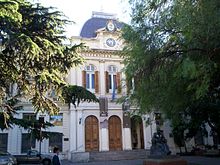 Presidencia de la UNLP.
Presidencia de la UNLP.
La Plata hosts one of the most renowned universities in Argentina, the National University of La Plata (Spanish: Universidad Nacional de La Plata, UNLP). It has over 75,000 regular students, 8,000 teaching staff, 16 faculties and 106 available degrees.
UNLP students and professors include:
- Raúl Alfonsín (Law degree in 1950) President of Argentina (1983–1989)
- Néstor Kirchner (Law degree) President of Argentina (2003–2007)
- Cristina Fernández de Kirchner (Law degree) President of Argentina (current; term 2007-2011)
- René Favaloro (Medicine degree in 1949, creator of the technique for coronary bypass surgery)
- Carlos Saavedra Lamas (law teacher, and rector, Nobel Peace Prize recipient)
- Ernesto Sábato (Physics PhD in 1937)
- Mario Bunge (Physics-Mathematics PhD in 1952)
- Florentino Ameghino (professor of geology)
- Juan José Arévalo (Philosophy PhD in 1934, 24th President of Guatemala)
- Emilio Pettoruti
- Pedro Henríquez Ureña
Four high school institutes are under UNLP control, three of them are located in La Plata:
- Rafael Hernández National High School (Spanish: Colegio Nacional Rafael Hernández)
- Víctor Mercante Lyceum (Spanish: Liceo Víctor Mercante)
- Fine Arts High School (Spanish: Bachillerato de Bellas Artes)
La Plata is also home of other three universities:
- Universidad Católica de La Plata
- Universidad Notarial Argentina
- Facultad Regional de la Universidad Tecnológica Nacional.
Students come to these four universities from every part of Argentina and other countries, giving the city a rich young multicultural lifestyle.
There is also an international school for translators, Traductorado.
Architecture and composure of the city
La Plata is a planned city, urban planning paradigm of the late nineteenth century. It is also an example of "hygiene", which was becoming important in that time.
The trace of the city, designed by architect Pedro Benoit, characterized by a strict grid, and its many avenues and diagonals. The convergence of the two major diagonals, 73 and 74, which cross the city from east to west and from north to south, respectively, takes place in Plaza Moreno. This square, in whose center is the foundation stone, the heart of the city, is the main square of the city and it is between the City Hall and the cathedral located at 14 N ° 1943 between 51 and 53, High Gothic, with its towers 112 m high, could be completed only in 1999. Highlights of the city are the Museum of Natural Sciences, the building of the Interior, the Provincial Legislature, the new theater and the hippodrome. Many of these buildings were built at the time of the founding of the city, following an international call for proposals. They are often called "buildings erected" and most of them are on the shaft foundation, which blocks are located between 51st and 53rd streets.Another work is the parent company of Banco de la Provincia de Buenos Aires, located between the streets 6, 7, 46 and 47. This building was designed by architects Juan A. Buschiazzo and Luis Viglione. It opened on 19 April 1886, being amended in 1913 and in the 1970s.
It is a very green city, with its largest so-called "Paseo del Bosque" (or simply 'the forest'), with its lake, amphitheater Martin Fierro, the Zoo and Botanical Garden Victorian astronomical observatory, and Natural History Museum, part of the UNLP, with its famous collections. Other attractions are the nearby Parque Pereyra Iraola great and so-called Republic of children in which it is said, he would have inspired Walt Disney to build Disneyland then, there are videos that prove that Disney, prior to building the park, visited the Republic Children's during his visit to Argentina.Architecturally the neo-Gothic cathedral called La Colorada, the former central railway station, in 1977 the city lost due to a fire, one of its most valuable monuments: the Teatro Argentino de La Plata, predominantly neoclassic style. Instead they built a new brutalist style theater. The city also has the Estadio Ciudad de La Plata influenced by modern architecture High-tech architecture, through a national competition which was amended in a subsequent project to expand capacity and cover. Is anticipated that by mid-2010s concrete deck semitransaparente Kevlar and plastic resins (which is still in Customs).
Awards received by the city
The city was awarded at the Exposition Universelle in Paris in 1889, an event in which the new city are the two gold medals awarded in the categories "City of the Future" and "Better performance built."
La Plata Cemetery
The municipal cemetery of La Plata was enabled in 1886 to work as a necropolis of the new capital of the province of Buenos Aires. It was designed by Pedro Benoit, who was also responsible for the design of the city. It lies on the intersection of Avenue 31, 72 and diagonal 74 in the southern tip. It has outstanding architectural features, both on his porch as in many of their family vaults, including neoclassical, Neo-Gothic, Art Nouveau (in its variant of Catalan Art Nouveau), Art Deco and Egyptian revival. The main entrance is an impressive neo-classical portico with Doric columns.
Its annex the Jewish Cemetery, part of the Asociación Mutual Israelita Argentina in La Plata, located on Avenue 72.
Sports
The most popular sport in the city, as in the whole country, is football. Among the many clubs that play football in the city, two of them stand out above the rest and these are the clubs Estudiantes de La Plata and Gimnasia y Esgrima La Plata, they both play in the First Division of Argentine football. From these two teams came out great players like Martín Palermo, Francisco Varallo, Juan Sebastián Verón and his father, Gustavo and Guillermo Barros Schelotto, Leandro Cufré, among others. The city also has the Liga Amateur Platense de fútbol that encompasses dozens of clubs in the region, such as: Club Atlético Estrella de Berisso, La Plata Fútbol Club, Asociación Nueva Alianza, Club Everton, among others.
Basketball has a place in the Torneo Nacional de Ascenso (National Tournament Ascent), through Gimnasia y Esgrima La Plata . In addition, through the Asociación Platense de Basquetbol, the city has leagues and tournaments for all levels and categories (First, Second Ascent, U21, Junior (U19), Cadet (U17) ,Kids (U15) Pre-Kids (U13), which involved Clubs: Gimnasia y Esgrima La Plata, Estudiantes,Centro Fomento de Los Hornos Club Atenas, Unión Vecinal, Centro de Fomento Meridiano V, Club Cultural y Deportivo Juventud, among others.
Auto racing also has its importance in the city from the hands of the Turismo Carretera. For this competition is a racetrack called Autódromo Roberto José Mouras in honor of the historic Chevrolet driver died in Lobos in 1992.[12] Other information relating to motorsport in the city has to do with the last Argentine Formula 1 pilot, who was the "platense" Gastón Mazzacane that after 21 races in Formula 1 came to compete in the Champ Car and Top Race V6.
Rugby, meanwhile, is a comprehensive discipline of fans in the city. The most representative clubs are: La Plata Rugby Club, Club San Luis, Los Tilos, Universitario and Albatros.
Of note is the traditional seat of turf in the city. La Plata has a race track, the third in order of competition and offer careers in the country.
Volleyball teams include Gimnasia y Esgrima and Universitario.
Hockey also claims two teams, Universitario and Santa Bárbara.
Culture
The culture has a major role in the city of La Plata. This is reflected in the large amount of cultural centers, theaters, museums, cinemas and libraries that are in the city, as well as the Universidad Nacional de La Plata and the observatory.
- Cultural centers: Centro Cultural Pasaje Dardo Rocha, Centro Cultural Islas Malvinas, Centro Cultural Estación Provincial, Centro Cultural Viejo Almacén El Obrero, Centro de Cultura & Comunicación, Centro Cultural El Núcleo, Centro Actividades Artísticas CRISOLES, Centro Cultural Los Hornos, Centro Cultural y Social El Galpón de Tolosa.
- Theaters: Teatro Argentino de La Plata, Teatro Municipal Coliseo Podestá, Anfiteatro Martín Fierro, Teatro La Nonna, Teatro La Hermandad del Princesa, Sala 420, Taller de Teatro de la UNLP, Complejo El Teatro, Teatro La Lechuza.
- Museums:[13][14] Museo de Ciencias Naturales, Museo de Arte Contemporáneo Latinoamericano, Museo Provincial de Bellas Artes, Museo Municipal de Bellas Artes, Museo de Arte Fra. Angélico, Museo de Instrumentos Musicales Colección Dr. Emilio Azzarini, Museo Histórico del Fuerte de la Ensenada de Barragán, Museo y Archivo Dardo Rocha, Museo Almafuerte, Museo del Teatro Argentino, Museo José Juan Podestá, Museo de la Catedral, Museo Indigenista Yana Kúntur, Museo Internacional de Muñecos, Museo del Automóvil Colección Rau, Museo del Tango Platense, Museo Policial Inspector Mayor Vesiroglos, Museo Histórico Contralmirante Chalier (Escuela Naval de Río Santiago), Museo Histórico Militar Tte. Julio A. Roca, Museo de Anatomía Veterinaria Dr. Víctor M. Arroyo, Museo de Artesanía Tradicional Juan Alfonso Carrizo, Museo de Astronomía y Geofísica, Museo de Botánica y Farmacognosia Dr. Carlos Spegazzini, Museo y Casa de Descanso Samay Huasi, Museo de Física, Museo de Historia de la Medicina Dr. Santiago Gorostiague, Museo Biblioteca de Química y Farmacia Prof. Dr. Carlos Sagastume, Museo de Odontología, Museo de Ciencias Agrarias y Forestales Prof. Julio Ocampo.
- Libraries: Biblioteca Central General José de San Martín, Biblioteca Municipal Francisco López Merino, Biblioteca de la Universidad Nacional de La Plata, Biblioteca de la Legislatura de la Provincia.
- Cinemas: Cinema San Martín, Cinema 8, Cinema City, Cinema Paradiso, Cinema Rocha, Cine Select, Espacio INCAA km. 60.
There were big personalities in the cultural sphere from the city: Paula Almerares (opera singer, soprano); Dante Anzolini (conductor); Efraín U. Bischoff (historian), José Walter Gavito (sculptor), Osvaldo Golijov (classical composer), Robert Noble (journalist and socialist politician, founder and first editor of the newspaper Clarín), Emilio Pettoruti (painter), Ernesto Tenenbaum (Reporter), María Dhialma Tiberti (writer), Iñaki Urlezaga (classical dancer), Álvaro Yunque (writer), Jorge and Federico D'Elia (actors); Adabel Guerrero (dancer, actress), Alejo García Pintos (film and television actor), Benjamín Rojas (actor), Freddy Villarreal (comedian, actor), Héctor Bidonde (actor), Juan Palomino (actor), Oscar Alberto "Lito" Cruz (actor), Maxi Ghione (actor), Pablo Andrés Martínez (actor), Carlos Mancinelli (musician), among others.
It is worth mentioning other important personalities, not being natives of La Plata, influenced the city's cultural life as Raúl Amaral (writer, poet and journalist. It was part of Ediciones del Bosque), Joaquin V. Gonzalez (historian, educator, writer and politician) and Rafael Hernández (politician and journalist), both founders of the UNLP, Pedro Bonifacio Palacios "Almafuerte" (Poet); Josefina Passadori (writer) Ernesto Sabato (writer and artist), Carlos "Indio" Solari (musician and band member platense Redonditos Patricio Rey and Ricotta), among others.
The city has a great attraction to music, whereas all festival concerts are organized. In addition, this is formed big band music and folklore of Argentina such as Los Redondos, Virus, Guasones, Opus Cuatro, among others.
Festivals, celebrations and events scheduled
The city of La Plata has the particularity of being the only place (with Berisso and Ensenada) in the country where the burning of Momos (Dolls similar to those cremated at the Fallas festival in Valencia, Spain) is held every New Year's Eve. Hundreds of dolls are burnt to celebrate the end of the year and the beginning of a new year. Competitions for the best doll is awarded by the La Plata municipality and media.[15][16]
Every 18 April is International Day For Monuments and Sites.[17] That day, buses with tour guides leave from the Centro Cultural Pasaje Dardo Rocha to the various historical monuments of La Plata, Berisso and Ensenada, being the activity free.
In addition, every year on 19 November, the anniversary of the city is held with recitals and a fireworks show at the Plaza Moreno.
In La Plata, as well as in all of Argentina, the first day of spring is celebrated along with National Student's Day on 21 September. On this date, the municipality organizes concerts both in the Paseo del Bosque and Plaza Moreno.
Patron saint
The patron saint of the city and the party of La Plata is Saint Ponciano, the 18th pope of the Catholic Church, who died in Sardinia on 19 November 235.[18] On 19 November is the feast of the Catholic parish of St. Pontian, pope and martyr.[19]
Tourism
The most important tourist sites are located in the heart of the city's founding, between Streets 51 and 53, being the center of the city's Plaza Moreno. The square separates two great works of the city: the Metropolitan Cathedral of La Plata "Immaculate Conception" and the Palacio Municipal.
The city of La Plata has many monuments and historical sites. Among them are: the Banco Provincia de Buenos Aires headquarters, the Curutchet House, Casa de Gobierno Provincial, Casa Mariani - Teruggi, Centro Cultural Islas Malvinas, Centro Cultural Meridiano V, Centro Cultural Pasaje Dardo Rocha, Iglesia San Benjamín, la Legislatura Provincial, Museo de Ciencias Naturales, the Quinta Oreste Santospago, the Rectorado de la UNLP, Museo Ferroviario of Tolosa, the Teatro Municipal Coliseo Podestá, the Anfiteatro Martín Fierro, the Estadio Ciudad de La Plata, entre otros.
Moreover, staying at the city of La Plata the visitors can tour the monuments of the neighboring cities of Berisso and Ensenada (formerly part of La Plata), finding among these to the Street New York, the Swift Refrigerator, Ukrainian Catholic Parish "Our Lady of the Assumption, Old Station Cultural Centre, Fort Barragán and Historical Museum, the Ensenada Rotary Bridge, among others.
People
- Category:People from La Plata
- La Plata's Mayors
Sister cities
La Plata has signed long-lasting cooperative ties in the nature of twinning, with the following cities on the dates specified:
 Porto Alegre (Brazil) 1982
Porto Alegre (Brazil) 1982 Bologna (Italy) 1988-11-23
Bologna (Italy) 1988-11-23 Beersheva (Israel) 1989-04-18
Beersheva (Israel) 1989-04-18 Zaragoza (Spain) 1990-10-12
Zaragoza (Spain) 1990-10-12 Asunción (Paraguay) 1993-02-20
Asunción (Paraguay) 1993-02-20 Concepción (Chile) 1993
Concepción (Chile) 1993 Louisville, (U.S.) 1994
Louisville, (U.S.) 1994 Maldonado (Uruguay) 1994
Maldonado (Uruguay) 1994
Footnotes
- ^ Thomas Bradley: The photographer of Dardo Rocha (in Spanish)
- ^ Felipe Pigna, Los Mitos de la historia argentina, 3, ed. Planeta Historia y Sociedad 2006, p. 153.
- ^ Lucesole, María José. "Por Iglesia y en secreto". La Nación. http://www.lanacion.com.ar/nota.asp?nota_id=210477. Retrieved 2009-02-08.
- ^ "La fundación de La Plata". Archived from the original on 2009-07-25. http://web.archive.org/web/20090725035553/http://ar.geocities.com/paginajosemariarosa/tema09.htm. Retrieved 11 de enero de 2009.
- ^ "Especiales - La Plata Histórica". http://www.eldia.com.ar/especiales/historicas/index.htm. Retrieved 11 de enero de 2009.
- ^ "Historia de La Plata". http://www.laplatamagica.com.ar/Historia.htm. Retrieved 11 de enero de 2009.
- ^ "Historia de La Plata en "El álbum de La Plata"". http://historiadelaplata.blogspot.com/. Retrieved 11 de enero de 2009.
- ^ Time and date
- ^ [1]
- ^ [2]
- ^ "Estadísticas de Educación de La Plata". Municipalidad de La Plata. http://www.estadistica.laplata.gov.ar/paginas/matricula.htm. Retrieved 2009-02-10.
- ^ "Circuito de La Plata". ACTC. http://www.actc.org.ar/php/circuitos.php?pista=la_plata. Retrieved 2009-03-17.[dead link]
- ^ "Atracciones, Museos". La Plata Vive. 2010. http://www.laplatavive.com/atracciones/museos.asp. Retrieved 26 September 2010.
- ^ "Red de Museos de la UNLP". Universidad Nacional de La Plata (UNLP). 2010. http://www.unlp.edu.ar/articulo/2008/6/28/redmuseosunlp. Retrieved 23 October 2010.
- ^ "Recorrida por los tradicionales muñecos de Fin de Año". El Día. 2007. http://www.eldia.com.ar/edis/20071231/20071231084719.htm. Retrieved 2009-03-17.
- ^ "Finalizó el concurso: el domingo se conocerán los cinco ganadores". El Día. 2008. http://www.eldia.com.ar/edis/20080102/20080102072256.htm. Retrieved 2009-03-17.
- ^ "Cientos de platenses en un tour por los museos". El Día. 2009. http://www.eldia.com.ar/edis/20090419/laciudad24.htm. Retrieved 2009-04-20.
- ^ San Ponciano
- ^ Basílica de San Ponciano. Historia.
- ^ "Bruera firmó Convenio de Hermanamiento con la Alcaldesa de Toluca.". Municipalidad de La Plata. http://www.gestion.laplata.gov.ar/noticias/221-bruera-firmo-convenio-de-hermanamiento-con-la-alcaldesa-de-toluca. Retrieved 23 October 2010.
References
- Soler, Ricardo (1982). 100 años de vida platense. El Día. Sociedad Impresora Platense..
External links
- (Spanish) Official government website
- (Spanish) http://www.mapa.laplata.gov.ar Interactive map of La Plata
- (Spanish) Municipal information: Municipal Affairs Federal Institute (IFAM), Municipal Affairs Secretariat, Ministry of Interior, Argentina. (Spanish)
La Plata's web guides
- (Spanish) LaPlataMap
- (Spanish) Calle 52
- (Spanish) LaGuiaX
- (Spanish) Cualbondi (Buses on/from/to La Plata)
Provincial capitals of Argentina La Plata, Buenos Aires · San Fernando del Valle de Catamarca, Catamarca · Resistencia, Chaco · Rawson, Chubut · Córdoba, Córdoba · Corrientes, Corrientes · Paraná, Entre Ríos · Formosa, Formosa · San Salvador de Jujuy, Jujuy · Santa Rosa, La Pampa · La Rioja, La Rioja · Mendoza, Mendoza · Posadas, Misiones · Neuquén, Neuquén · Viedma, Río Negro · Salta, Salta · San Juan, San Juan · San Luis, San Luis · Río Gallegos, Santa Cruz · Santa Fe, Santa Fe · Santiago del Estero, Santiago del Estero · Ushuaia, Tierra del Fuego · San Miguel de Tucumán, Tucumán
 Categories:
Categories:- Capitals of Argentine provinces
- La Plata
- Planned cities
- Populated places in Buenos Aires Province
- Populated places established in 1882
- Urban planning in Argentina
Wikimedia Foundation. 2010.

